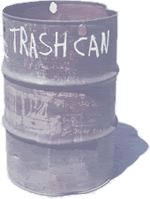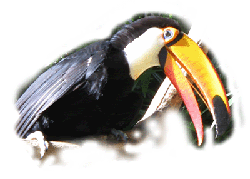Since it's the durian season (it is in Sarawak la), I've decided to give a community message by presenting to you...
HOW TO CHOOSE A GOOD DURIAN
Hey! At least I give you credit!
Every year, with the coming of the durian season, the air is filled with a heavy 'odoromatous' presence; and the streets are lined with hastily composed pyramidal piles and altars for the King of fruits - the durian.
And every year we are confronted again by the same eternal question of how to choose a good durian.
The first step in choosing a good durian is to grasp the durian that takes your fancy by its stalk and hold it in front of your eyes for close scrutiny. It is advisable while doing this to stand with your legs apart or "kang-kang" as the durian and its stalk may decide, at this very moment, to part company, with disastrous consequences to your foot. If you do not wish to stand in this manner then I would advise you to have safety boots on.
An age old adage says that you cannot judge a book by its cover. But some 'so-called' durian experts claim that they can judge a durian by its thorns. This is all "bull-shit" or shall I say "cow-dung" so as not to offend the Women's Liberation Movement. So why must you look at a durian if you cannot judge a durian by its thorns. It is to look for holes or 'lubangs'.
Durian holes generally fall into four categories:
Squirrel holes
Durians with squirrel holes are generally ripe and quite tasty as the squirrel who has been at it would gladly testify. However, these durians are considered 'second paw' (second hand) and being minus a few seeds should be purchased only after a generous discount.
Worm holes
Durians with worm holes have worms and other creepy crawlies in them and should be rejected unless, of course, you are one of those lovers of Swiss Cheese.
Man-made holes
These are small triangular openings cut into the durian so that the customer could have a sneak preview of the fleshy quality of the durian. Obviously if the durian is still there, it has been rejected. Would you take someone's reject?
Open backside type
Durians with their bottoms with are gaping or beginning to gape have seen better days - 2 or 3 to be precise - where they have been paraded, manhandled and put back on the shelf, rejected by all and sundry. Leave them in place.
Now, having given the durian the visual test, you can now proceed to the next important step. Take the durian into your hands, with your fingers gripping the spaces between thorns, approximate it next to your ear at the side of your head and shake. No, not your head, you idiot!
Stop and listen intently. If you hear some movement inside, examine the durian again as you may have missed out some small worm holes and there may be creepy crawlies moving inside the durian. If there are no worm holes and no creepy crawlies and you still hear something moving, then I suggest you go to the nearest E.N.T. specialist or Chinese barber to have your ear examined for creepy crawlies.
Pardon my disgression. Now why shake the durian, you ask. Good question!
Remember the other old adage - 'empty vessels make the most noise'. This holds true for the durian. If you hear vigorous hollow movements of seeds when you shake the durian - the fruit is all seed and no flesh - reject it. If there is no movement at all on shaking, and the durian feels heavy for its size, the fruit is unripe or if ripe, waterlogged. Reject also. If you detect some faint movement and the fruit feels relatively light for its size - go on to the next step - the ultimate olfactory test which separates the men from the boys.
For this step, hold the durian gently in your hands as you would your loved one and place in front of your nose and inhale deeply. If you find dirt, dust and dried leaves in your nostrils, stop at once, and send the durian back to the vendor for a thorough cleaning.
Having ensured that the durian is clean and that there is no impediment in your nasal passages repeat the inhalation process, with both thumbs and thenar eminence cupped to exclude any extraneous smell. If you detect an over rich, strong, fetid odour, it indicates that the durian is overripe. Reject, especially if the stalk looks somewhat dry.
If you detect no smell at all also reject as the fruit is unripe.
But if you detect a faint aroma of bitter sweet butter scotch and almonds with a bouquet of wild honey and a hint of smoked oak then you have hit the jackpot and found yourlself a durian with a thick, creamy, treacle like, bitter sweet tasting flesh for you to savour and enjoy. And finally, as for the proper and correct way to open durians, bring them to me .......
All rights reserved.Converted to HTML and published on the web by his son, Alex Tan.






0 Comments:
Post a Comment
Go back to the Trash Can's Home